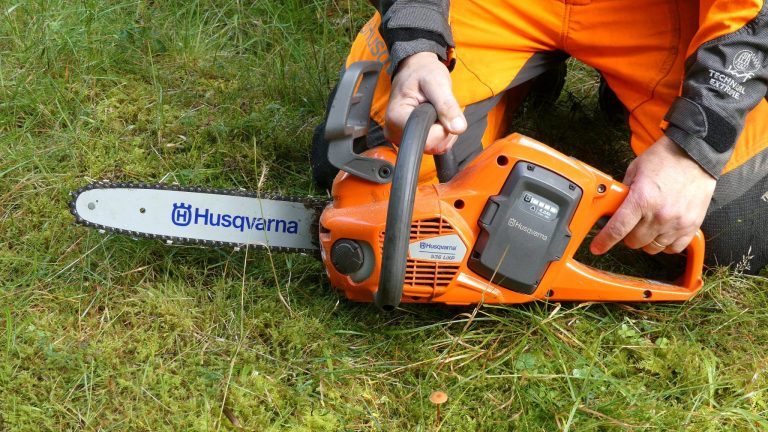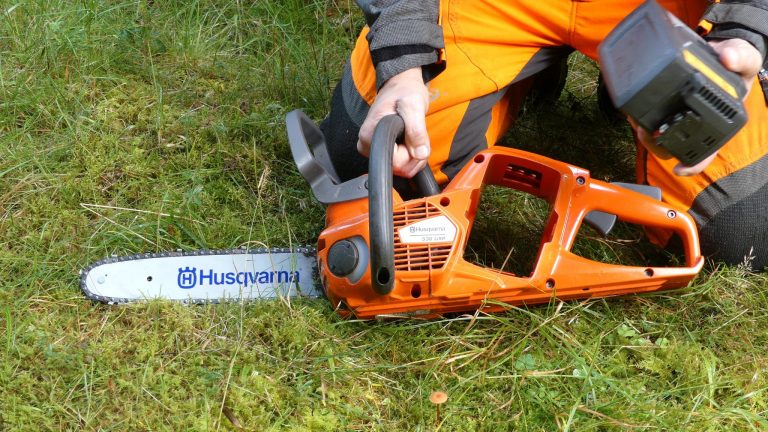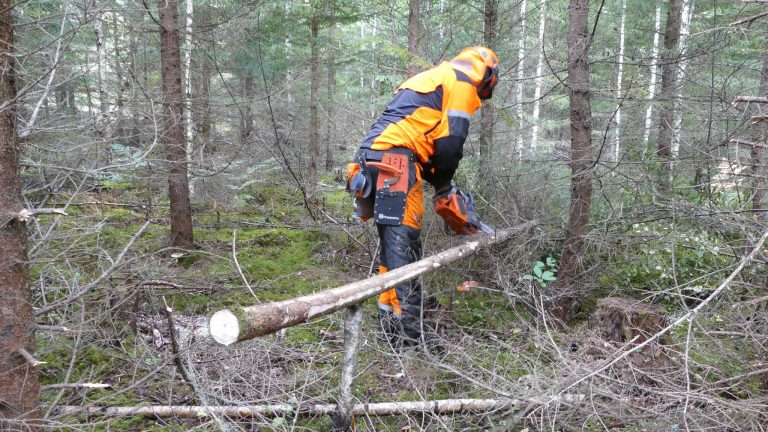Is a battery chain saw like Husqvarna 536 LiXP just a toy? Or a working tool with capacity for professional use? NordicWoodJournal.com tried it out and put a new Husqvarna battery chain saw through it’s paces in full day logging work. Well, it’s not about mature, full size timber felling but nice thinning work in a young stand.
This autumn, it has been a lot of focus on new, big 70 cc professional chain saws from both Husqvarna and Stihl. But this text and video goes in the opposite direction. With full focus on s small chain saw. Powered with batteries. The Husqvarna 536 LiXP.
I don’t have any own experiences of using a battery chain saw myself, but I became more curious about how well they actually work? Which performance has the best battery saws? Can you use them for “real” forest work day after day and how does it work? For this purpose, I found a 22-year-old spruce stand in and spent a full day there with thinning work. But before that I went through the chain saw and the big battery bag I borrowed from Husqvarna to see what was there:
1 Battery chain saw Huswqvarna 536 Li XP
1 power supply 230V charger (QC 330W) to charge the batteries at home
1 pc 12V charger (QC 80F) to charge the batteries in the car or the tractor
5 pcs of 4.2 Ah batteries (BLi 150)
1 pcs 9.4 Ah battery (BLi 300)
The smaller batteries (BLi 150) of 4.2 Ah have now been replaced by a larger 5.2 Ah battery. The new battery (BLi 200) also seems to be slightly lighter (1.3 kg/2,9 lbs) compared with the old one. I could not find weight data on the old battery on HVA’s site, but at dealer sites there were info of 1.5 kg/3,3 lbs. The large 9.4 Ah battery BLi 300 weighs 1.9 kg/4,2 lbs.
The saw weight 2.6 kg/5,7 lbs without cutting equipment and with 5.2 Ah battery it picks up at about 4.2 kg/9,3 lbs depending on the length of the bar and the chain. If you instead place the larger 9.4 Ah battery it weights in at about 4.8 kg/10,6 lbs.
I made sure all the batteries were fully charged and it was quite fast to charge. Just over 35 min for a 4.2 Ah with the power cord QC 330W.
Testing Husqvarna 536 LiXP
Then it went to forest to test! There was no major problem understanding how the saw worked. Button on – green light – throttle and cut! If you did not run the saw for a while, then it shut itself off to save battery. Then you need to press the button again. If you turn on the chain brake, it does not turn off as quickly, but stays in standby mode longer.
The sound
You may be tempted to believe that a battery saw goes silent when there is no gas engine that roars. And, of course, it’s quiet between the times you press the handle. However, when you cut, it is a loud, sharp and unpleasant sound from the chain. A bit like at the dentist’s but higher. Of course, this sound is also there when you work with a normal saw, but is drowned by a more comfortable(?) engine sound. Ear protection is a must also when working with the battery saw and of course also the visor.
Has the 536 LixP power enough?
The answer is definitely yes for such a stand of early thinning. Felling small trees takes no longer time than with a professional saw. The cutting power is enough and there is enough speed on the chain. But as soon as the diameter of the stems increases, you feel that it is a little slower but it does not make a big difference during a working day in thinning work. I do not really know when it starts to feel awkward but if many of the stems are around 20 cm (8 inch) or more it will be tough. In my case it was mostly less than 15 cm (6 inch) stems and it was no problem.
How long do the batteries last?
It is probably a question like “how long is a string”? Depending on how hard the saw is loaded. If you stand on your wood yard and cut 20 cm (8 inch) birch firewood you can run batteries empty quite quickly. Do you work as an arborist and spend most of your the time preparing, securing, climbing and handling material, it may be enough for a full day?
I can only explain how it worked in my case and here it was possible to run about an hour on the 4.2 Ah batteries (BLi 150). If you would instead use the new 5.2 Ah-Hour batteries (BLi 200), they should last a quarter longer. The 9.4 Ah (BLi 300) battery lasted about two hours, so it’s a linear relationship between capacity and time. If you don’t have the ability to charge the batteries in the woods, like with the 12V charger in a car or tractor or have an extra car battery at your ATV. Then you need to buy and carry many batteries. Three pcs 9 Ah batteries weigh 5.7 kg/12,6 lbs and cost a good deal to buy. On the other hand, you do not have to spend on alkylate gasoline during saw and battery lifetime (about 1500 charges).
Eco-Mode
The Husqvarna 536 LiXP has an Eco-Mode that can be activated with a button above the start/stop button. According to Husqvarna, it will reduce power output by about 10%, thus extending operating time. I tried the saw in Eco-Mode but didn’t notice any real difference in capacity. It sounds like it doesn’t rush as much, but I did not notice any difference in performance when I was delimbing. Maybe a little bit slower in felling but very marginal difference.
An annoying detail was that when you restarted the saw after it had shut down itself, it didn’t remember it was closed in Eco-Mode. So you need to push both the activate-button and the Eco-Mode button every time you start again. A little bit annoying but that should be an easy thing to fix I guess? Take it as a hint Husqvarna!
Why battery saw?
Maybe about the same reason we discuss electric cars? Achieving a fossil-free world. Now, emissions from chainsaws probably not represent a particularly large proportion of the World’s environmental impacts, but if you want to contribute with a fossil-free “life style”, then the battery saw is definitely an opportunity. (Provided you do not charge the batteries from your diesel tractor or petrol car or your electricity is generated by coal or oil power plants).
Another aspect is the working environment. With today’s alkylate gasoline, the nearest working environment around the saw has become much healthier, but with the electric saw, it becomes completely clean and free from exhaust gases.
I am not very well acquainted with the efficiency of (gas) chainsaws compared to what this electric version offers in effect on the chain. An electric motor usually has a high efficiency compared to an combustion engine, but the battery weight may spoil that equation? Otherwise, could that be an argument? That you can get a lighter gear with sustained performance. Or more effect for the same weight?
If you want to reduce weight on what’s “carried in your hands” as much as possible, you can hang on a large back-pack battery instead. Question is how it works with the “umbilical cord” between saw and battery? If it gets stuck and in the way or if it works well. Could be interesting to test anyway.
Other reflections
Chain and bar feel quite scanty, but are still well dimensioned to the little saw. I had a 12-inch bar with 3/8 pixel chain (1.1mm gauge) mounted at the saw I borrowed. It worked well, cut efficiently and it was easy to sharp the chain. I had a chain jump when I delimbed a standing stem a bit sloppy but it was easy to put it back again. It’s not possible to make a bore-cut with this chain but it’s rarely needed in this kind of work.
There was a lot of small branches and twigs stuck in the chain house from time to time. Especially thin, dry spruce twigs from stem delimbing and pruning. Sometimes it became so thick that it stopped or went sluggish and then I had to clean it out. It was not that difficult, but it is important to turn on the chain brake so you don’t do anything stupid. You don’t have the same feeling of “danger” when you stop your fingers in a silent saw as if a gas engine had been on idle.
Summary
It would definitely be possible to work full days with such a battery saw in light thinning stands. Ideally, if you bring a vehicle to the forest then you can charge batteries while cutting. Otherwise, you need to buy (and carry) many batteries.
Video
Here is a video from my test. It’s in Swedish but it has subtitles in English so it should be possible to understand.
Weight & Price
If you use the new larger batteries you need at least three pcs to be able to do a full day of work in thinning. Here below you can see weight and cost for the different components. Target prices according to Husqvarnas US website (September 2017):
All of the different batteries was not found on the US site and those (marked*) is presented with Swedish prices recalculated to US$:
Husqvarna 536LiXP without battery: Weight 2.6 kg. Price US$ 399,95
BLi 150 battery: Weight 1,5 kg, 4,2 Ah, Price US$ 169,95
BLi 200 battery: Weight 1,3 kg, 5,2 Ah, Price SEK 2400/US 301,90*
BLi 300 battery: Weight 1,9 kg. Price SEK 3200/US 402,50*
Power Charger QC 330W: Price US$ 129,95
12V Charger QC 80F: Price US$ 59,95
*No information of prices could be found at Husqvarna US site so we used the Swedish price (incl VAT) and converted from SEK to US$.















